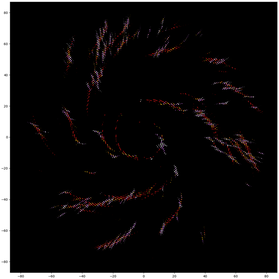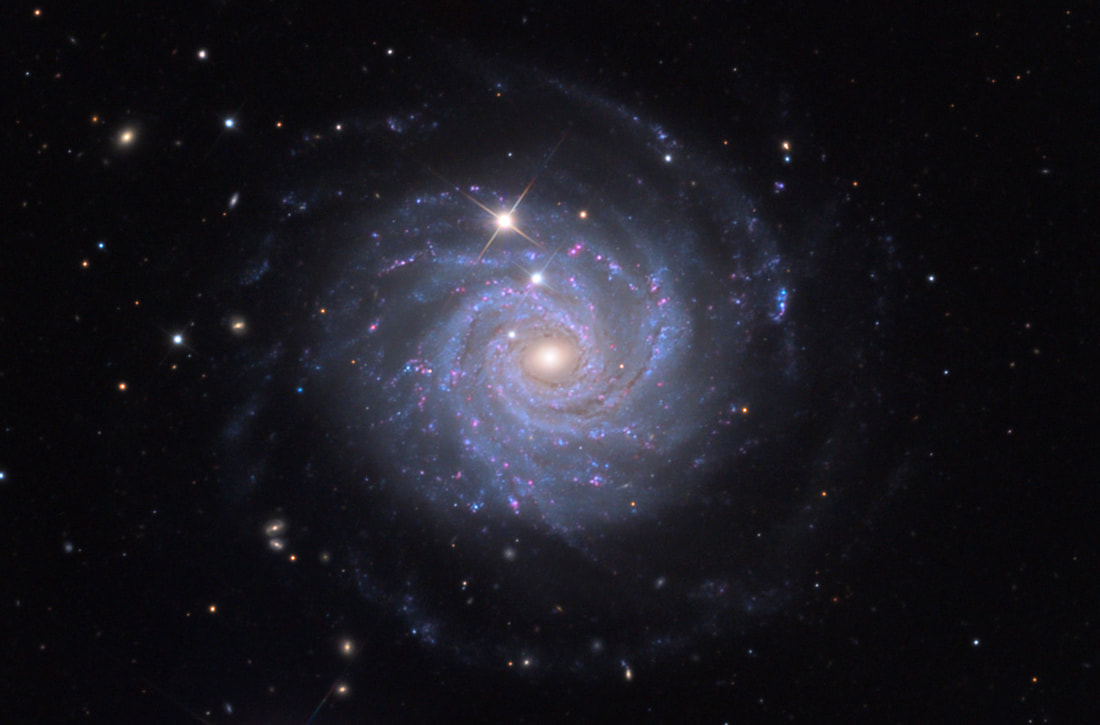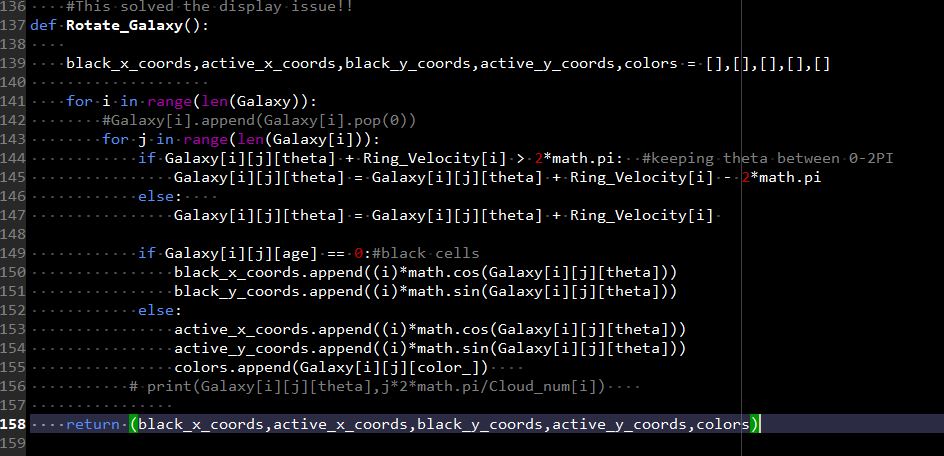Enter the Cellular Automaton! Create a galaxy by having each cell represent a cloud of gas from which stars form. Then arrange the cells in concentric rings to create a disk for the galaxy. Each ring of gas will rotate at some angular velocity with differential rotation between them. Finally apply rules that make the clouds of gas in each cell active (or not). One basic rule for clouds of gas is that a SuperNova can EXPLODE in a region of the galaxy. This triggers adjacent regions of gas to collapse and form stars. And this new star formation might also trigger other neighbors to form stars as well. It isn't 100%. These clouds of gas also age and eventually become inactive until perhaps once again triggered to form more stars. In fact the details of the rate of formation, the likelihood of affecting neighbors, the numbers of clouds (cells), their ages and the rotation rate of the rings together all play a part in the final macro pattern that evolves.
Recently I completed a program that does exactly what I describe above. It is meaningful to me on many levels (see below), but first here is one run of the program showing how by applying these simple rules you can end up with something like a spiral galaxy. I suggest actually seeing it on YouTube at full screen in HD.
Isn't that cool? Just by working on a micro-scale with a bare minimum of states and rules- patterns emerge that echo what is seen in nature. This kind of model certainly does not completely characterize the way galactic structures form- but there is a convincing argument that some of what is observed may come from these processes.
Below is another version using very different parameters which more clearly shows the pixel interactions.
This program is meaningful to me because I wrote this in college- specifically in the fall of 1995. I know this well because this is when I met Miwa... who remarkably would agree to marry me (later). It was in a computational physics course (romantic right?) lead by Dr. Phil Pinto of the University of Arizona. Many students in the class did not have experience programing, but I had a solid foundation in C. So I asked Dr. Pinto if there was something interesting to model and he suggested the perfect thing! He gave me a paper written in 1976 by Mark Mueller and David Arnett titled: "Propagating star formation and irregular structure in spiral galaxies." In it they describe the model I simulated above... only they used printouts on paper! They could not use nearly as many rings (cells) or iterations compared to what I can easily do on my computer today. However back in 1995, with my inefficient C code, I honestly was not doing much better than the paper printouts. Tens if not hundreds of thousands of cells are necessary to make this simulation even start to look reasonable.
Fast forward 20+ years. I eventually joined a small team of astronomers at the UofA and I committed myself to learning this new-fangled programming language called Python. It opened the door for me to once again look at this program on my personal computer. And just yesterday... it happened, I once again saw something similar to what I had seen years ago on my screen. I improved the code in many ways that go far beyond my original version such that I think this result is closer to what the original paper envisioned and it has much greater flexibility in the levers and parameters I can adjust (play with!).
Special thanks to Dr. Robert Vanderbei for his patience as a sounding board for this project. I approached Dr. Vanderbei in the hopes of learning how to transmute this program into a Javascript that will run in a browser window. Check out his website and you will see why. He has hundreds of toy models doing exactly this kind of thing. Indeed, once I presented him with the idea he made his own version of this galaxy model. It will take time, but with his example I hope to create a similar interactive version in the future as well.
4 Comments
In college I helped lead the Astronomy Club and wanted to take on the project of installing a telescope (that was not being used) at a facility (also not being used). It would become the club telescope if it was possible. So I drafted a letter to go before the head of the Astronomy department (Dr. Strittmatter) as well as a well-liked Optics professor (Dr. Bickel) asking them to fund the project and match each other's monies. The pitch I wrote is below and both agreed to assist! Dr. Bickel in particular did something very nice. He wrote to me and explained that this proposal was far better than most of what crossed his desk in the professional world. This is was both a very kind and a *very powerful* thing to do. I subsequently used this confidence to put forth more "pitches" that helped create the Kitt Peak National Observatory Visitor Center evening programs as well as the Mount Lemmon SkyCenter for the University of Arizona. I was probably 22-24 years old at the time. Everyone has those things in life that determine the direction of the narrative... this was one of mine. Tumamoc Hill Telescope Project Located on a mountain just outside of the Tucson complex there is a small abandoned structure once used to house a medium sized telescope. However, the building has remained unused longer than the lifetime of the author of this proposal. The lack of desire to maintain this site or ambition to rectify the status of this structure certainly attributed to its current state of useless disrepair; however, the members of the University of Arizona Astronomy Club have had a long standing desire and motivation to rebuild this site and use it as a club privilege and educational tool. The owners of the site, namely Steward Observatory, have graciously allowed the club to repair the site and install a sixteen-inch reflecting telescope which sadly, suffered a similar past as the building into which it will be installed. This is what makes this project so inviting- it allows for existing resources to be repaired and recycled creating tools that may once again prove themselves useful and educational. Another advantage of this kind of project is, when it comes right down to it, it is cheap. The money required to repair the site and install the telescope is negligible compared to other projects which insist on new technologies and expensive materials and provide the same educational value. Moreover, the members of the club strongly believe they are rebuilding something more than just a structure to put a out-of-commission telescope in- they also feel they are rebuilding an interest and motivation to engage in hands-on science, which is of mutual interest to both student and teacher. The ideas which are stated above are not result of years of wishful thinking. They are instead the product of determined action and patience. Major clean-up and rebuilding activities have already been executed with great success. New roofing material has been put on the structure and it has been sealed to prevent further water damage. A new deadbolt-lock was also installed over the winter break. The next couple of weeks will also be work intensive as the club paints the structure and redesigns a custom mount for the telescope. In that respect, my personal contribution to this team effort will be to help in the restoration of the telescope and its installation on Tumamoc Hill. The first duty that needs to be performed is to clean the primary mirror of the telescope. Stellar Vision, a local store dedicated to astronomical equipment, quoted the club a price of forty dollars to collimate and clean the telescope. This is an excellent deal. I am also involved in the designing of a new mount for the telescope. The mount that is currently on the two-pier foundation is made to hold a telescope smaller than the one we wish to install. Using the computer program AutoCad a new design based on the old one was drawn up and is ready to be submitted to the appropriate machine shop once funding is available. I look forward to seeing this project reach its natural conclusion- that is, a telescope placed in an abandoned building by the end of the semester. The scope of this project will certainly encompass not only undergraduate club members, but also any activities that support the mission of the astronomy club such as giving children from various schools an opportunity to participate in astronomy related activities (as the club has done in the past). There is no doubt that the night of "first light" will be far brighter than any other atop Tumamoc Hill. (Some day I might come back here and post the pictures of the work in progress and final installation of the telescope... Unfortunately in the decades that followed, not all future students were quite as motivated to maintain it... and once again things fell into disrepair. Ah...entropy.) |
AuthorAdam has been interested in astronomy since the age of 4... maybe earlier. Archives
November 2020
Categories |



 RSS Feed
RSS Feed